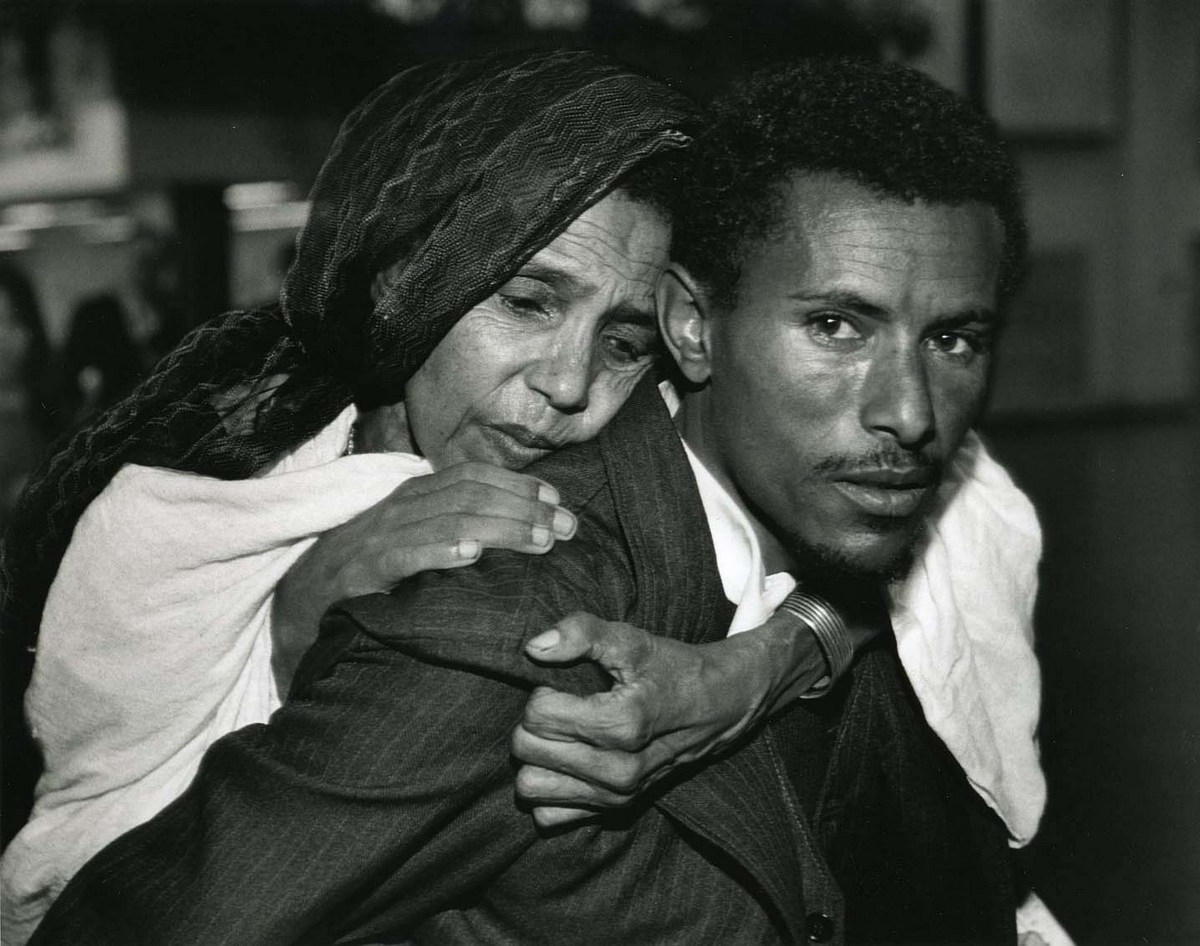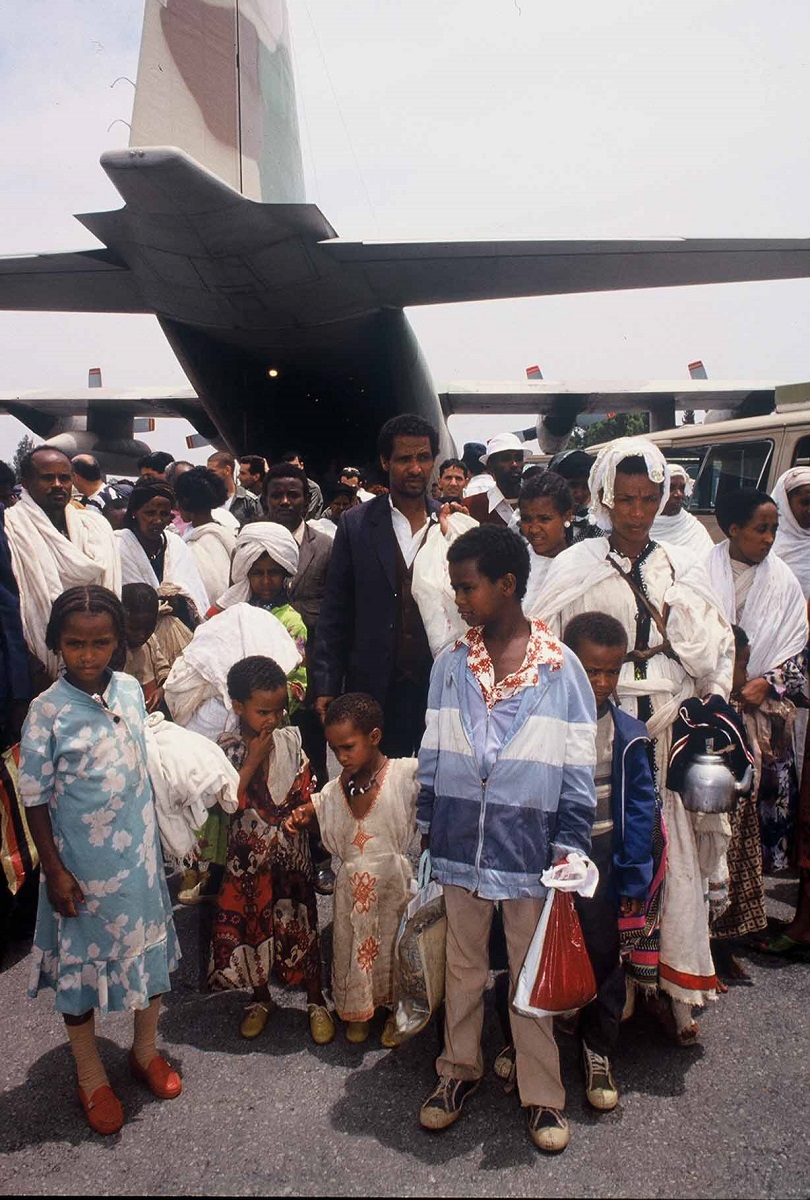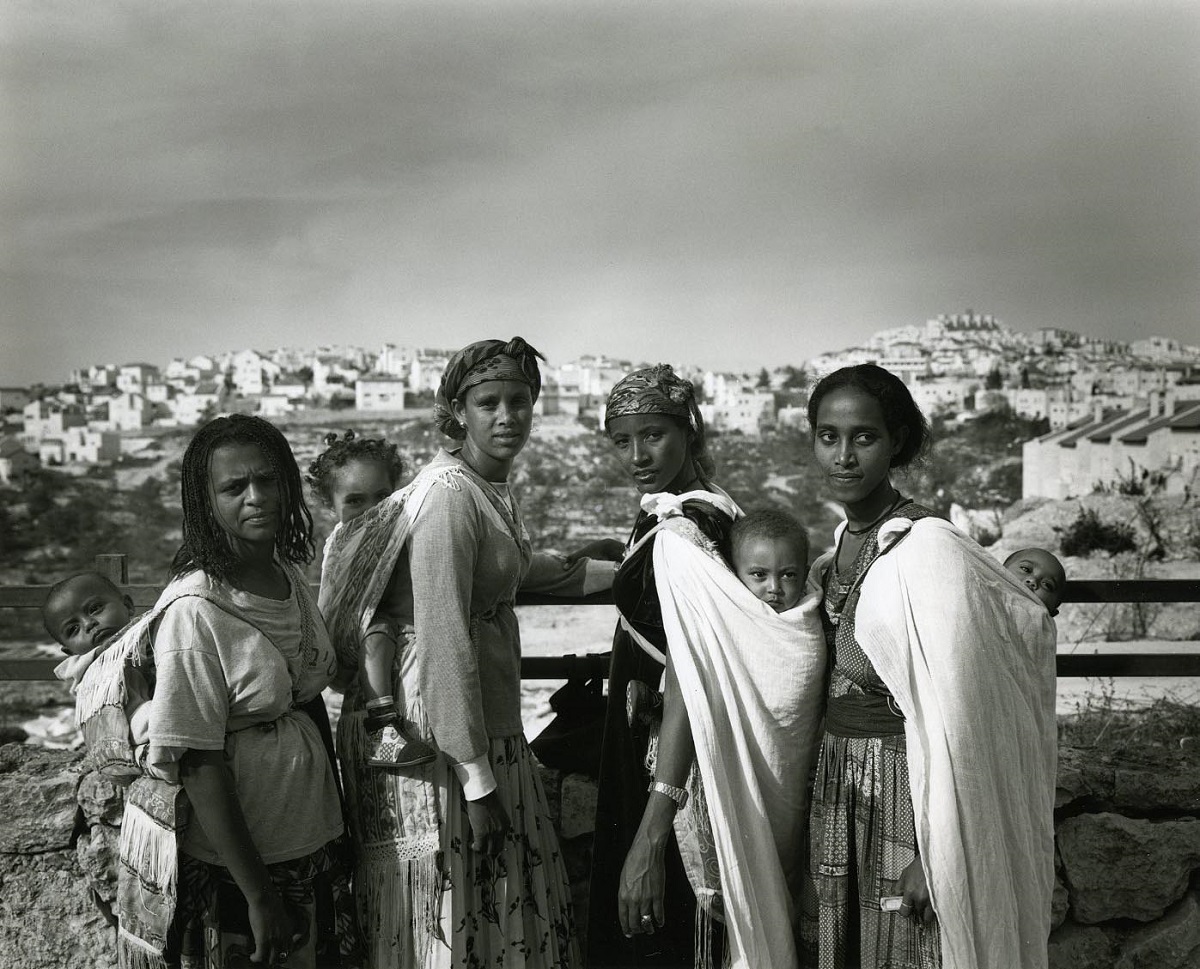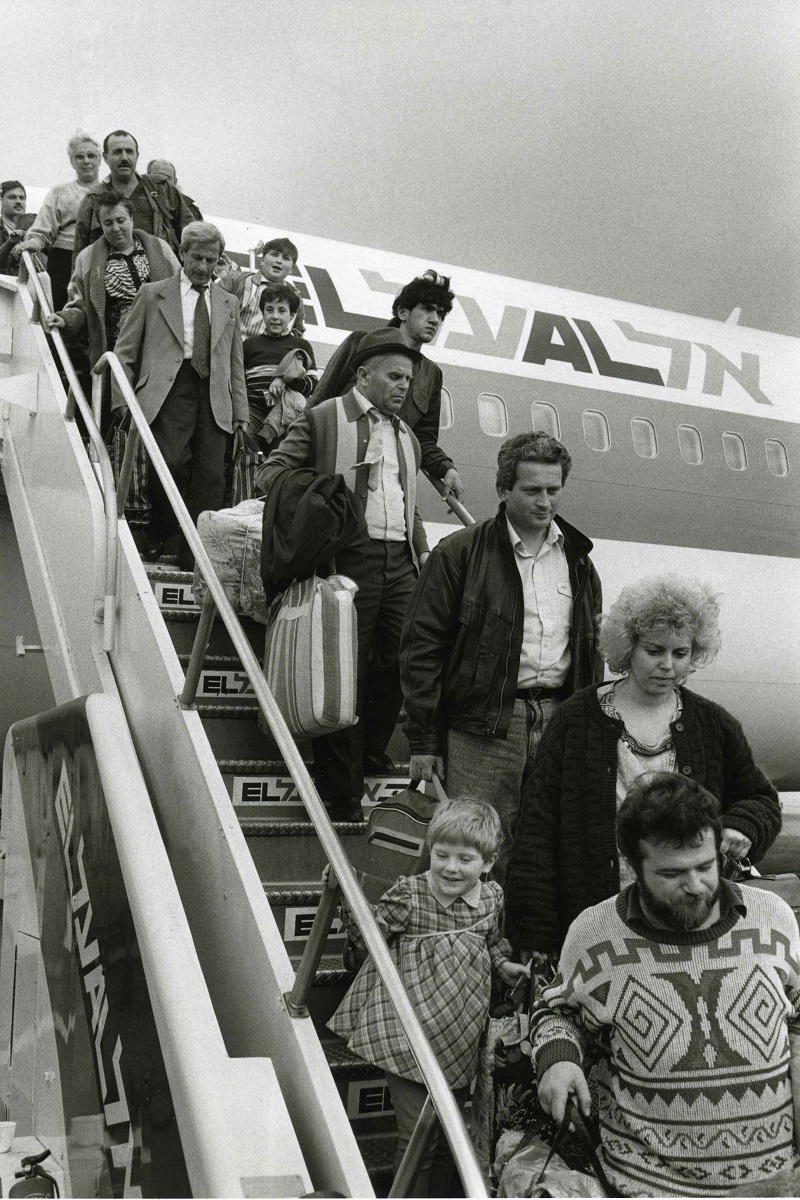Full Curriculum
Unit IV: Israel in Focus
Lesson 4: Returning to the Land
| Materials: | 50 minutes |
| Preparation: | Copies of Israel Worksheet_4A: “Returning to the Land: Introductory Activity” (one per student) Copies of Israel Worksheet_4B: “Returning to the Land: Hok ha-Shvut” (one per student) Classroom board Computers with Internet accessRelated photographs by Zion Ozeri, for example:
Photos of Early Immigration to Israel: |
| Preparation: | Prior to students’ arrival, photocopy and staple worksheets and gather research materials for investigating Jewish refugee populations in Israel. Depending on your classroom resources, you may wish to secure your school’s media center or technology lab so that students have as much access to the Internet and other research resources as possible. |
| Learning Objectives: | In this lesson, students will:
|
| Big Idea: | As we learned in a previous lesson, Israel is considered the homeland for Jews all over the world. But how does Israeli law define and protect the rights of one who is an oleh (a Jew who comes to Israel to live)? Which Jewish populations have sought refuge in Eretz Yisrael in the last century, and how does their presence in Israel reflect the blessing of Kibbutz Galuyot that is recited three times a day in the Amidah prayer? |
Warm-Up/Introduction Activity (8 minutes):
- As students enter class, distribute the Israel Worksheet 4A: “Returning to the Land: Introductory Activity” and divide students into pairs. Ask students to discuss the photograph (“Operation Exodus, 1992”) and the related text (Kibbutz Galuyot) with their partners, responding to the worksheet questions to guide them. After five minutes, ask students to share their worksheet responses, and encourage related discussion.
- Then, revisit the “home versus homeland” concept from the earlier lesson. How is this idea of home/homeland interwoven with Kibbutz Galuyot? Point out that the return of Jews to Israel from the “four corners of the earth” is the goal of the Zionist movement. Introduce Hok ha-Shvut, The Law of Return.
Text Activity (15 minutes):
- Explain that Hok ha-Shvut ( ) – The Law of Return – grants every Jew in the world the right to settle in Israel. The Knesset first passed the law on July 5, 1950. It was amended in 1954 and in 1970.
- Distribute Israel Worksheet 4B: “Returning to the Land: Hok ha-Shvut.” Read through the law section by section as a class, focusing on the following discussion questions as a guide (allow time for further student questions or additional discussion):
1950 Law of Return
– Right of Aliyah: When was the State of Israel founded? Why do you think this law was enacted shortly thereafter? In what way is becoming an oleh a “right”? Why is this right central to the idea of Israel as a Jewish State?
– Oleh’s Visa: For what reasons would an oleh’s visa be denied?
– Oleh’s Certificate: What type of person does this section describe? How does it relate to the previous section?
– Residents and Persons Born in This Country: Who is considered an oleh according to this part of the law?
– Implementation and Regulations: What do you think the Minister of Immigration does? Why would someone in this position be in charge of this matter?
1954 Amendment
– Amendment of Section 2(b): How does this amendment change the original law? Who has been added as a person ineligible to be an oleh?
– Amendment of Sections 2 and 5: What do you think the Minister of the Interior does? Why do you think this change may have been made?
1970 Amendment
– Addition of Sections 4A and 4B: Who is granted oleh status in this section? Who is not? How does this expand your understanding of who is an oleh? How is the question of “who is a Jew?” specified, and why is this important here? How do you feel about this?
– Amendment of Section 5: Why would the Knesset be involved in this matter?
– Amendment of the Population Registry Law: How does this section further clarify who is or is not a Jew? Why is this important here?
Photo Activity/Research (25 minutes):
- Discuss the terms “refuge” and “refugee”:
– What does “refuge” mean? (A refuge is a place where one is protected from danger.)
– What is a “refugee,” and why do people and communities seek refuge? (A refugee is someone who has been forced to leave a country. People and communities seek refuge to escape war or for religious or political reasons, such as persecution in their homelands.)
– How is Israel a refuge for the Jewish people? (Revisit Kibbutz Galuyot and Hok ha-Shvut. Jewish individuals can return to Israel to visit or as an oleh to live in Israel. But Jews and Jewish communities around the world can also return to Israel when they are in distress.) - Explain to students that they will now be learning about some Jewish populations that have sought refuge in Israel in 20th century. Divide students into small groups, and assign each one of the following Jewish populations (more than one group can study the same population):
– Ethiopia via Sudan via Operation Moses (1984)
– Ethiopia via Operation Solomon (1991)
– Former Soviet Union via Operation Exodus (1990s)
– Exodus from Arab and Muslim countries (1947-1972) - Using available classroom resources, including computers with Internet access and reference materials from the library, each group should investigate and take clear notes on the following (written on the classroom board for easier student access):
– What life was like for Jews in assigned country at the time of the relocation to Israel
– Who aided the refugee efforts
– Key events and people involved
– Size of the refugee population then and now in Israel - Also distribute photographs by Zion Ozeri that are relevant to the different groups. For example:
Operation Moses:
Schoolgirl
Mother and Son, Ramla, Israel, 1986
Operation Solomon:
A Sign and a Witness, Ben Gurion Airport, Israel, 1991
Backpack, Ben Gurion Airport, Israel, 1991
Operation Solomon, Ben Gurion Airport, Israel, 1991
From the Four Corners of the Earth, Ben Gurion Airport, Israel, 1991
Absorption Center, Mevaseret Zion, Israel, 2008
Operation Exodus:
Honorable Discharge, Ben Gurion Airport, Israel, 1992
Operation Exodus, Ben Gurion Airport, Israel, 1992
Hebrew Class, 1994
A New Land, Hadera, Israel, 1998
Arab and Muslim Countries:
Moroccan Rabbi, Beer Sheva, Israel
As part of their research, students should study the photographs closely. What is going on in each? What clues do the photographs provide about the experiences of the subjects either during or after their immigration to Israel? You might ask students to do an objective/subjective reading of one of their assigned photographs (see Lesson 1 of the Main Curriculum for more about objective/subjective looking [link]).
- If necessary, students can continue research in a future class or at home.
Wrap Up/Review (2 minutes):
The Talmud teaches, “Kol Yisrael areivim zeh ba’zeh ( ) – All of Israel is bound up together” (Babylonian Talmud, Shevuot 39a). How does this text relate to today’s lesson?
Homework:
Once research is complete, each pair or small group will write a newspaper article covering the emigration of their assigned Jewish population from their home country to Israel. Each article should include one of Zion Ozeri’s photographs with a one-paragraph caption written by students, as well as at least one additional photograph (with photo credits), and at least one related map, plus a headline and byline with an appropriate date. After future revision, articles should be typed and each “published” on a regular piece of paper with all other required elements, and photocopied in a tabloid-style newspaper for the class (and other classes, if desired).
For the front page, the class should create a name for their newspaper for a masthead, and individual students or groups can write introductions to the paper, offer brief related text analyses, draw illustrations, and include other relevant information.
Extension Activities:
- Students can photograph a local Jewish immigrant or refugee and interview him or her about his or her experiences. They can then compile information into a “profile” article to add to the class newspaper.
- As a class or individually, conduct a study of Israel’s population in terms of ethnic demographics. Israel’s Central Bureau of Statistics provides information on their website (Hebrew version at – cbs.gov.il; English version at CBS Site). You may focus on the entire country or one particular city. Students can create a graph or series of charts that illustrate the data and then write a brief analysis of their findings.
- Have students investigate other historical aliyot to Israel, including aliyah from Eastern Europe before 1948, from the Soviet Union in the 1970s, and France in the 1990s.
- Learn about what was happening in Israeli politics and society when Hok Ha-Shvut was first passed (1950) and amended (1954 and 1970). Students can write a reflection about the Law of Return from the perspective of one of the Israeli leaders responsible for the legislation at that time.
If your students have not yet done the Introductory Lesson, we recommend beginning with that lesson before progressing through the lessons in this unit.
IMAGES

Schoolgirl, Israel, Circa 1989
Shortly after arriving from Ethiopia, this schoolgirl draws a picture in celebration of Hanukah. Israel is home to a diverse mixture of Jews with varying traditions, customs and national origins.

Mother and Son, Ramla, Israel 1986
Jews have lived in Ethiopia for hundreds and hundreds of years. But in the 1970s and 1980s, life became very difficult for them. They were no longer safe. So, in 1984, the Israeli government organized a secret operation—known as Operation Moses—to bring Ethiopia’s Jews to Israel. In six short weeks, almost 8,000 Ethiopian Jews were rescued through the Sudan. It was a difficult journey, and many suffered or died along the way. When the operation ended, about 15,000 Jews still remained in Ethiopia.
The mother and son in this photograph were brought to Israel as part of Operation Moses. They are shown here next to their new home, in the town of Ramla, not far from Tel-Aviv.

A Sign and a Witness, Ben Gurion Airport, Israel 1991
Jews have lived in Ethiopia for hundreds and hundreds of years. But in the 1970s and 1980s, life became very difficult for them. They were no longer safe. So, in 1984, the Israeli government organized a secret operation—known as Operation Moses—to bring Ethiopia’s Jews to Israel. In six short weeks, almost 8,000 Ethiopian Jews were rescued through the Sudan. It was a difficult journey, and many suffered or died along the way. When the operation ended, many Jews still remained in Ethiopia.
In 1990, Israel and Ethiopia reached an agreement that would allow Ethiopia’s remaining Jews to move to Israel. But before anything could be done, rebel forces threatened to topple the Ethiopian government. So in May 1991, as the rebels seized control of Ethiopia’s capital, the Israeli government organized an unprecedented rescue operation, called Operation Solomon. Beginning on Friday, May 24, and continuing non-stop for a day and a half, 36 El-Al jumbo jets and military transport planes carried more than 14,000 Ethiopian Jews to freedom in Israel.

Backpack, Ben Gurion Airport, Israel, 1991
Jews have lived in Ethiopia for hundreds and hundreds of years. But in the 1970s and 1980s, life became very difficult for them. They were no longer safe. So, in 1984, the Israeli government organized a secret operation—known as Operation Moses—to bring Ethiopia’s Jews to Israel. In six short weeks, almost 8,000 Ethiopian Jews were rescued through the Sudan. It was a difficult journey, and many suffered or died along the way. When the operation ended, about 15,000 Jews still remained in Ethiopia.
In 1990, Israel and Ethiopia reached an agreement that would allow Ethiopia’s remaining Jews to move to Israel. But before anything could be done, rebel forces threatened to topple the Ethiopian government. So in May 1991, as the rebels seized control of Ethiopia’s capital, the Israeli government organized an unprecedented rescue operation, called Operation Solomon. Beginning on Friday, May 24, and continuing non-stop for a day and a half, 36 El-Al jumbo jets and military transport planes carried more than 14,000 Ethiopian Jews to freedom in Israel.
The people in this photograph were part of Operation Solomon. The man carries his mother on his back as they enter the land of Israel for the first time. Look at the expression on their faces. How do you think they feel?
Here’s what the photographer, Zion Ozeri, had to say about the experience: “I was here [in the United States] at the time. Reading carefully through the Israeli newspapers and the New York Times, I felt that something was going to happen—some kind of an airlift. I smelled it in the air. So I called someone I knew at the Jewish Agency in Jerusalem, and I said, ‘What’s happening? Is it what I think is going to happen? Is there going to be an airlift?’ He said, ‘Are you crazy? I can’t talk to you about this over the phone.’ I said, ‘I understand. But tell me, should I just buy a ticket to come to Israel right now?’ And he said, ‘Yeah.’ I bought a ticket and I got there Friday afternoon. I put my luggage down at my parents’ house, took my camera, and said, ‘Goodbye, I’m going back to the airport.’ They said, ‘Why?’ I said, ‘I can’t tell you now, but you’ll know in a couple of days.’ And it was the most amazing thing. An hour or two after I got to the airport, they started landing. And you’d see babies who were being born on the planes. It was just amazing.”
Sample Texts:
.
All people, in every generation, must regard themselves as having been personally freed from Egypt.
– from the Passover Haggadah
, ; , .
, ; ,
My son, heed the discipline of your father,
And do not forsake the instruction of your mother.
For they are a graceful wreath upon your head,
A necklace about your throat.
– Proverbs (Mishlei) 1:8
-, , - , : , - - –. , - –-, : - , -, , .
And Moses said to the Lord, “Why have You dealt ill with Your servant, and why have I not enjoyed Your favor, that You have laid the burden of all this people upon me? Did I conceive all this people, did I bear them, that You should say to me, ‘Carry them in your bosom as a nurse carries an infant,’ to the land that You have promised on oath to their fathers?”
– Numbers (Bemidbar) 11:11-12

Operation Solomon, Ben Gurion Airport, Israel 1991
Jews have lived in Ethiopia for hundreds and hundreds of years. But in the 1970s and 1980s, life became very difficult for them. They were no longer safe. So, in 1984, the Israeli government organized a secret operation—known as Operation Moses—to bring Ethiopia’s Jews to Israel. In six short weeks, almost 8,000 Ethiopian Jews were rescued through the Sudan. It was a difficult journey, and many suffered or died along the way. When the operation ended, about 15,000 Jews still remained in Ethiopia.
In 1990, Israel and Ethiopia reached an agreement that would allow Ethiopia’s remaining Jews to move to Israel. But before anything could be done, rebel forces threatened to topple the Ethiopian government. So in May 1991, as the rebels seized control of Ethiopia’s capital, the Israeli government organized an unprecedented rescue operation, called Operation Solomon. Beginning on Friday, May 24, and continuing non-stop for a day and a half, 36 El-Al jumbo jets and military transport planes carried more than 14,000 Ethiopian Jews to freedom in Israel. The baby in this photograph was born en route to the Holy Land.

From the Four Corners of the Earth, Ben Gurion Airport, Israel 1991
Jews have lived in Ethiopia for hundreds and hundreds of years. But in the 1970s and 1980s, life became very difficult for them. They were no longer safe. So, in 1984, the Israeli government organized a secret operation—known as Operation Moses—to bring Ethiopia’s Jews to Israel. In six short weeks, almost 8,000 Ethiopian Jews were rescued through the Sudan. It was a difficult journey, and many suffered or died along the way. When the operation ended, about 15,000 Jews still remained in Ethiopia.
In 1990, Israel and Ethiopia reached an agreement that would allow Ethiopia’s remaining Jews to move to Israel. But before anything could be done, rebel forces threatened to topple the Ethiopian government. So in May 1991, as the rebels seized control of Ethiopia’s capital, the Israeli government organized an unprecedented rescue operation, called Operation Solomon. Beginning on Friday, May 24, and continuing non-stop for a day and a half, 36 El-Al jumbo jets and military transport planes carried more than 14,000 Ethiopian Jews to freedom in Israel.
The people in this photograph arrived in Israel as part of Operation Solomon.

Absorption Center, Mevaseret Zion, Israel 2008
The newly arrived Ethiopian immigrants in this photograph are staying at an absorption centers outside of Jerusalem until they find more permanent homes. Absorption centers provide temporary housing and an introduction to Israeli life for many new immigrants. The photographer, Zion Ozeri, explains how important these centers are: “The first few steps of any immigrant are very difficult not knowing the language, not knowing where to buy things, where to go. The Absorption Center helps the new immigrant. It’s something I don’t know if they have anywhere else in the world. It’s a place where you can ease yourself into it. For the first few months at least, they give them some money to buy food, and there is an ulpan (Hebrew class) for teaching the language. They kind of initiate them into new life in Israel, and how to deal with everyday things from the very, very simple things—like shopping in the supermarket—to finding a job.”

Honorable Discharge, Ben Gurion Airport, Israel 1992
Look at the expression on this man’s face. How would you describe it—fear, sadness, confusion, and joy? He has just arrived in Israel from the former Soviet Union. Under communism, Soviet Jews were not allowed to practice their religion openly and were often denied the right to immigrate to the U.S. or Israel. But after Gorbachev (the Soviet president) opened the doors to emigration in 1989, hundreds of thousands of Jews from the former Soviet Union flocked to Israel, with the help of Jews around the world.
These immigrants often arrived with very little and faced many challenges in their new homes. But the man in this picture has brought something very precious with him: the military medals he wears with pride. They serve as a reminder of his previous life; of the risks he took fighting for his country.
Here is what the photographer, Zion Ozeri, has to say about this picture: “I call it honorable discharge. He was obviously discharged from the Russian army. And many Jews, by the way, either sacrificed their lives or fought heroically during World War II…. I always look for the image that would define the moment, so to speak. So I sort of saw it in his face…. You see the flag, you see El-Al, and that look.”

Operation Exodus, Ben Gurion Airport, Israel 1992
In the 1990’s Operation Exodus helped to bring over about 1 million Jews to Israel from the former Soviet Union after the fall of communism, and the opening of the “Iron Curtain”. Many Jews were airlifted to freedom in Israel. Today, Israelis originating from the former Soviet Union make up about 15 percent of the population.

Hebrew Class, Israel 1994
Israel is a melting pot for Jews from across the world. New immigrants arrive constantly, speaking many different languages. Israel has created the ulpan, which is a language immersion program created to teach immigrants Hebrew quickly and efficiently. Many ulpan classes are held in absorption centers, like the one pictured here. This group of new Israelis comes from the former Soviet Union. Together, they will learn a new language as they adjust to a new country and culture.

A New Land, Hadera, Israel 1998
An immigrant mother from Russia, who just moved in to a home in, pointing the new landscape to her child.

Moroccan Rabbi, Be’er Sheva, Israel 2008
Since 1948, nearly a million Jews have come to Israel from Arab and Muslim lands—a large portion in just the first couple of decades of Israel’s existence. They came to escape religious intolerance and poverty, and to start new lives in their historic homeland. In 1948, there were over a quarter of a million Jews in Morocco. But anti-Jewish incidents spurred many to make aliyah. Jewish emigration from Morocco peaked in the mid-1950s and continued into the 60s. By the beginning of the 21st century, less than 5,000 Jews remain in Morocco.

